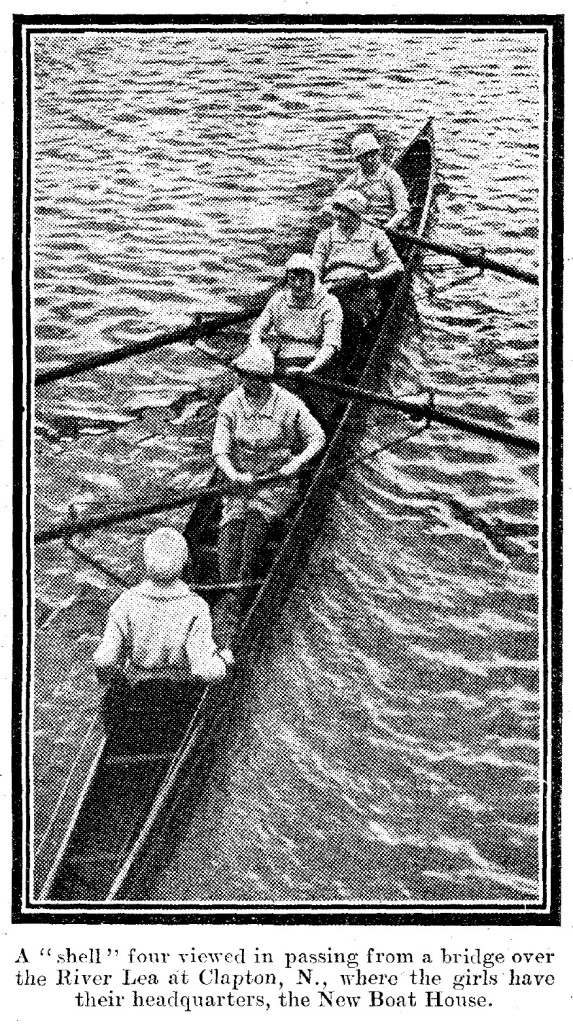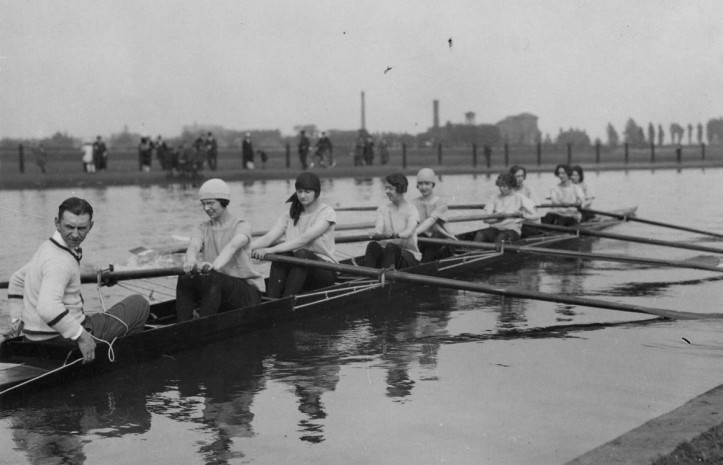
Clive Radley, author of The Radleys of the Lea, writes:
My great-aunt Phoebe Radley was born in Hackney, NE London, in 1876. She was the daughter of Vincent Radley, the proprietor of the V Radley and Sons boatyard business. In 1876, the boatyard business was based at Lea Bridge on the west bank of the Lea at Paradise Dock.

Phoebe lived with her parents at the Paradise Dock boathouse (apart from four years at Stratford-upon-Avon) until her mid-20s and there she learned to row. She would have liked to join a ladies’ rowing club, but this was at a time when there were hardly any women clubs for competitive rowing, a common view then being that competitive rowing was not a sport for ladies. By 1911, Phoebe had moved with her parents to a larger boathouse at Lea Dock, north of Lea Bridge and was described as a piano teacher in that year’s census, although this was probably not a full-time job.

The Lea Dock boatyard was not far from where Lord William Cecil had a town house in Clapton and this proved to be fortuitous for Phoebe, who had an ambition to start a rowing club for women. Lord William Cecil, the younger son of the Marquess of Exeter, was married to a member of Tyssen-Amherst family, who owned land alongside the Lea. Phoebe was an imposing figure, over six feet in height, and had a wide social circle group of moneyed friends and acquaintances. I only met her a few times – she definitely regarded herself as posh and had a maid.
Her dream was realised just before the 1914-18 War when she began a ladies club, using skiffs. After the War, the club members started using racing boats, and became known as Cecil Ladies rowing club as Phoebe had persuaded Lord William Cecil to become the club’s president. At first, they rowed in knee breeches and later started rowing in shorts. This caused a mild sensation and there was competition among newspapers to publish pictures of the ladies. (To view two Getty images of the young ladies from this time, click here and here.)
After the War, a Miss Stuart joined Cecil Ladies. She was the sister of Douglas Cecil Rees Stuart, who had stroked three Cambridge crews to victory in the Boat Race, in 1906-1908; the latter year, he stroked the British ‘A’ crew to take a third place in the eights in the Olympic rowing in Henley-on-Thames. Miss Stuart was a fine oarswoman and subsequently Cecil Ladies achieved a lot of success. When the Woman’s Amateur Rowing Association (WARA) was founded in 1923, Miss Stuart was a founding member and Cecil Ladies became the leading club in the WARA. The formation of a rowing association for ladies took place after the Amateur Rowing Association (ARA) took what would now be regarded as an unacceptable sexist stance in refusing to allow ladies to join the clubs of the ARA. The issue of amateur status for the WARA ladies was less of an issue than for the predominantly working class men’s clubs on the Lea as most of the WARA’s members were not ‘manual workers’.
The national press took a particular interest in this new phenomenon, a ladies rowing club, as evidenced by a number of the Daily Mirror articles in the early 1920s.






Cecil Ladies also appeared in two British Pathé news items in the 1920s, one showing the first Ladies rowing regatta taking place at Radley’s Lea Dock boatyard in 1925:
and another showing Lord William Cecil coxing a Cecil Ladies eight (1921):
There was a great quarrel when Miss Stuart started another club at Tyrells, known as Stuart Ladies, and Cecil Ladies gradually faded away. Phoebe apparently had a tendency to be autocratic and getting her own way which might partly explain the falling out.
Phoebe’s work life involved piano lessons, involvement in the Radley boatyard tea rooms after her father died, plus clerical support to the business. Her active role in the Radley firm ended when the tea rooms were destroyed in 1944 by a nearby V-2 rocket explosion. By this time, she was 68 years old, and, in reality, being hands-on in the tea rooms was not for her.
She was involved in local Hackney politics and had the nickname the ‘Venerable Phoebe’. In the picture below she is seen with the Mayor of Hackney at a Lea Regatta Prize Ceremony in 1950.

Phoebe died in 1964, at the age of 88, the longest living of Vincent Radley’s children. I was 19 at the time and was so busy with my own life at university that, sadly, I never asked her about Cecil Ladies. I have to thank my cousins June Cann, Tony Radley, Janet Szajer and my late uncle Laurie Radley for their recollections of her. This article is mainly based on my recently published book The Radley’s of the Lea.
To contact author Clive Radley, please use the following e-mail address: Clive-dot-Radley1-at-ntlworld-dot-com

My cousin June Cann nee Radley has emailed me to say that she was standing opposite Phoebe Radley in the prize giving picture. In fact our great Aunt told her, I have to go a meeting with the Mayor, so as a Radley you can present the Regatta prizes. June was about 17 at the time and was one of Sid Radleys two daughters who both were elite status rowers in the early 1950s.